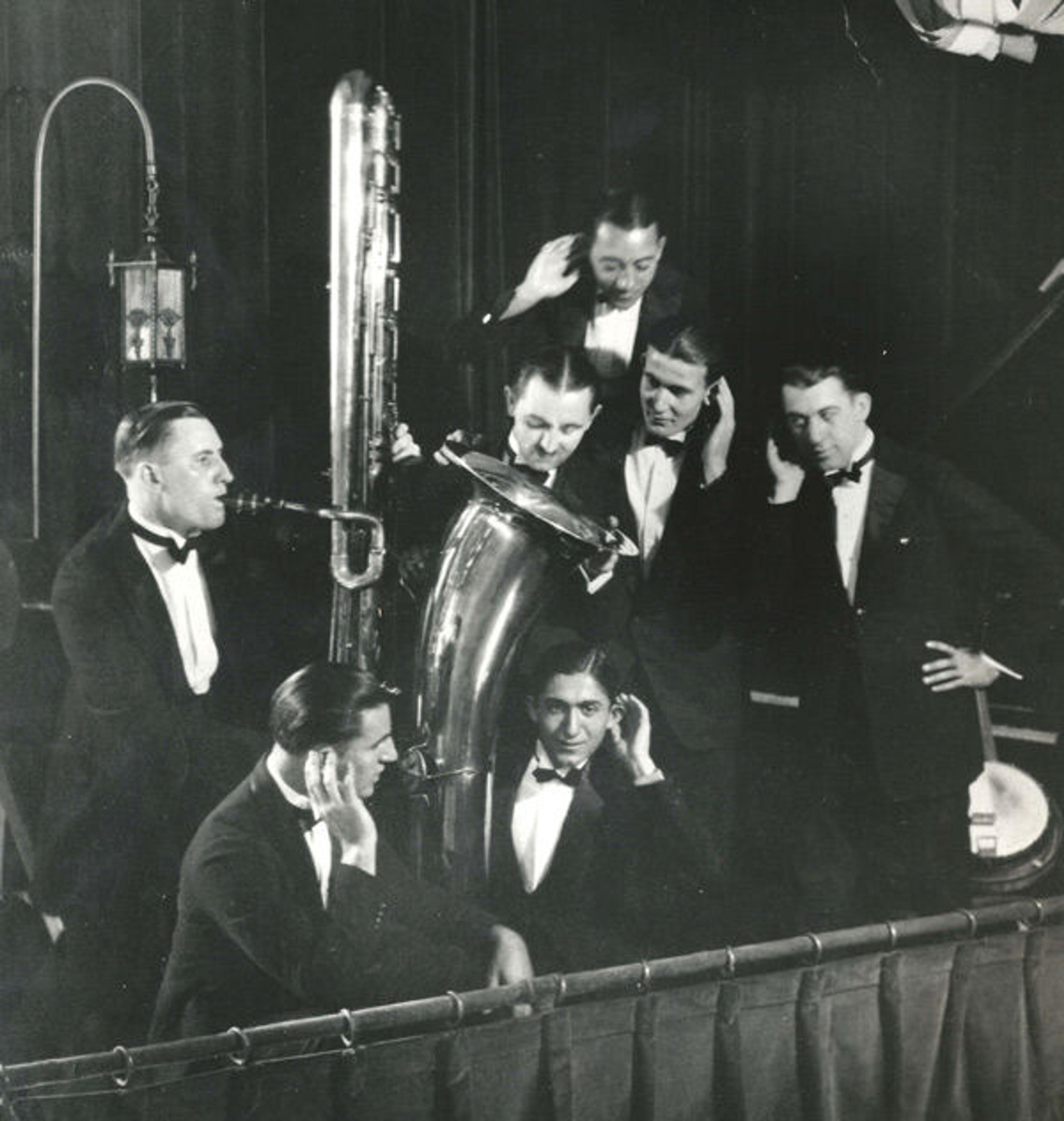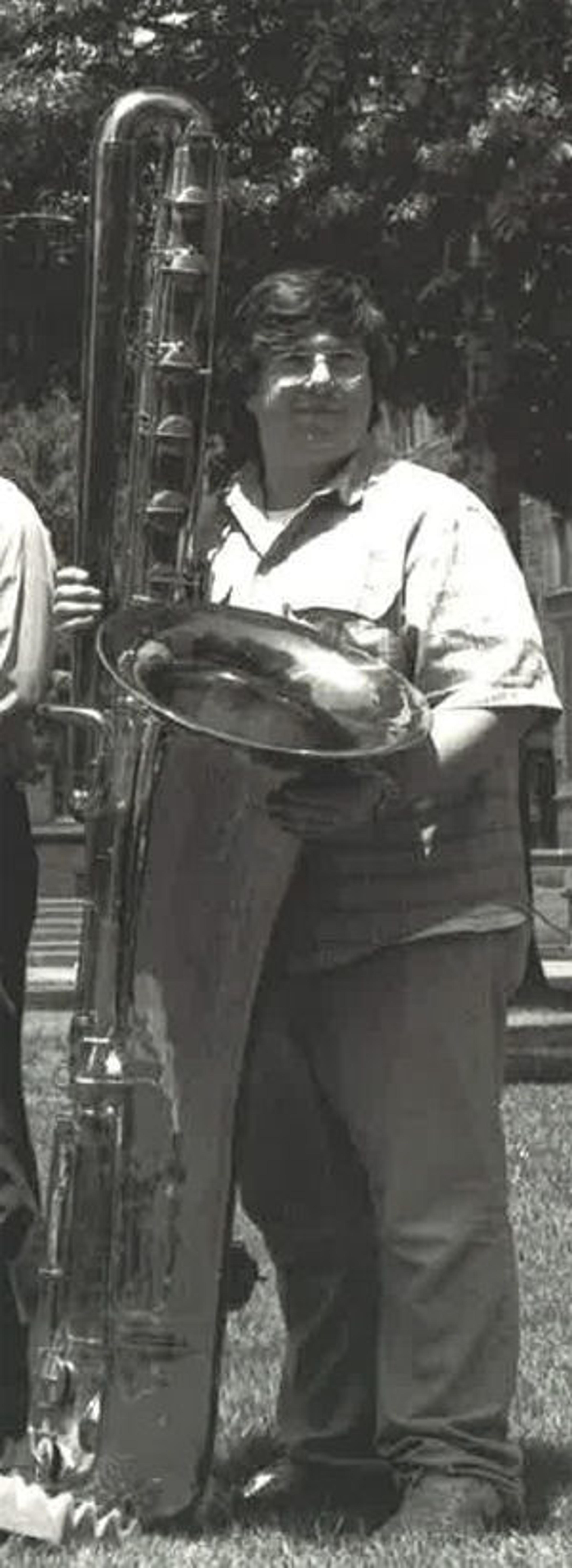The Magnificent Contrabass Saxophone

The Charles Houston Novelty Jazz Orchestra, ca. 1920. Photo courtesy of the author
From Bradley Strauchen-Scherer, Associate Curator in the Department of Musical Instruments:
Visitors to the Met's Celebrating Sax: Instruments and Innovation exhibition are greeted by the majestic contrabass saxophone that currently presides over gallery 682. It has been generously loaned to the Museum for the exhibition by leading saxophone performer, teacher, and historian Paul Cohen. In this post, Paul shares insights into the contrabass saxophone and relates the fascinating history of his instrument, made in Paris by Evette-Schaffer in the early 1920s.
«Hyperbole takes a back seat when it comes to the contrabass saxophone. Exaggeration and overstatement mean little when cast in the shadow of this gentle giant. Its stature defies description, while imposing a commanding presence that cannot be ignored. No, it does not leap tall buildings in a single bound, but it could stand in as one—looming at six feet, seven inches in height but of such graceful proportions as to invite warm and, at times, affectionate sentiment. It draws as much attention to itself tonally as it does visually. The resonance and depth of sound, floor-board rattling power, and deep range of this instrument (its lowest-sounding note is the lowest C-sharp on the piano) inescapably makes its presence known.»
It will come as no surprise that the contrabass was an integral part of Adolphe Sax's original conception of the saxophone. George Kastner, a leading French composer of the time, referred to the contrabass saxophone as early as 1844: "This instrument, which has been invented by Mr. Adolphe Sax, consists of a brass body with a clarinet-type mouthpiece. The timbre, really unique to the saxophone, has a noble and magnificent character which is approached by no other instrument."

The idea of a complete family of saxophones was firmly established as early as 1844. The first documented appearance of the contrabass occurred at the 1849 Industrial Exhibition in Paris, where Sax displayed many of his new and controversial instruments, including his complete family of saxophones. In an 1864 review, entitled "Concert of the Instruments Recently Invented by Adolphe Sax," A. Elwell remarked: "I particularly admired the beautiful sonority of bass and contrabass saxophones whose low range surpasses all instruments made until now, and whose sounds are produced with the same facility at either piano or forte levels."
Incredibly, the contrabass now on display at the Met was intended to be carried and marched in outdoor concert bands. One might think the instrument too heavy, bulky, and awkward to allow for useful mobility, not to mention the apparent physical strength and stamina required to even lift it off the ground. However, the two hooks that protrude from the body at what look to be unusual, unrelated angles serve to perfectly balance the saxophone when connected with a strap slung over the performer's back. With the weight supported and distributed so evenly in this manner, the strain is greatly minimized and the instrument can be carried with comparative ease. To prove this, I often paraded up and down my living-room floor while strapped to the contrabass and performing modest routines and jigs. That is, until an errant turn took out a pole lamp and a small table, and I relegated my contrabass steps to auditoriums and stadiums.
Judging by the balance hooks, this contrabass, one of twenty-five manufactured by Evette-Schaeffer between 1900 and 1930, may have been used for marching purposes for part of its musical activities, and is one of only ten Evette-Schaeffer contrabasses known to still exist. In the early 1920s it was used with New York City's Meyer Davis Band and the Charles Houston Novelty Jazz Orchestra of Philadelphia. After the ensemble disbanded in the late 1920s, the instrument remained unused, unpolished, and unknown, passing through the hands of several owners over many decades. I bought the saxophone in the early 1980s and brought it back to life through performances and recordings, culminating in its regal display at the Met. Now it's time for this magnificent contrabass to once again join the saxophone family and sound in deeply resonant glory.
The author poses with his contrabass saxophone before a concert at Yale University. Photo courtesy of the author
Hymn and Fuguing Tune No. 18 by Henry Cowell (1897–1965) showcases the extremes of the saxophone family. In this recording, Paul Cohen's contrabass saxophone, as played by Daniel Gordon, is heard in duet with a soprano saxophone played by Cohen.
See how you measure up to the contrabass saxophone—share your photos with @metmuseum on Twitter and Instagram, and be sure to tag your photos with #GiantSax!
The Musical Instrument Department @metmuseum welcomes you to see #GiantSax! pic.twitter.com/IaWcuViQ3K
— Jayson Dobney (@JayKerrDobney) November 25, 2014
Paul Cohen
Dr. Paul M. Cohen is an active saxophone performer and teacher, and currently serves on the faculty of the Manhattan School of Music.